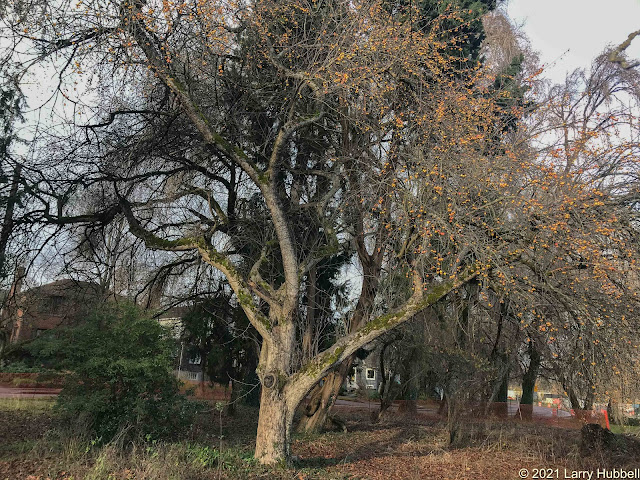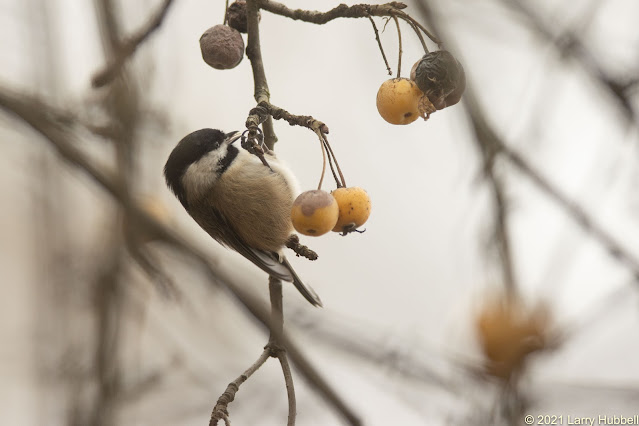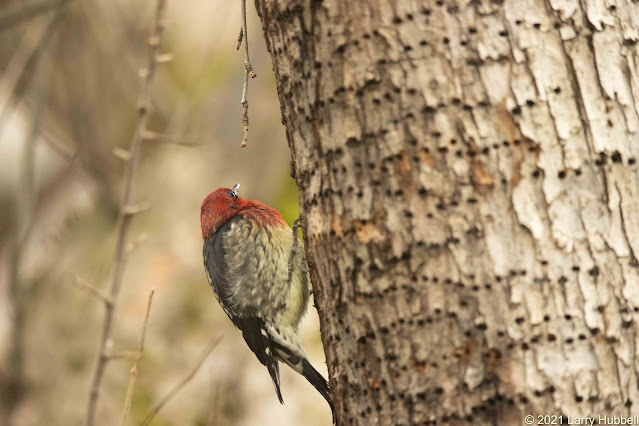Earlier this week, I was walking along Lake Washington Blvd, on my way to Montlake Cut, when I heard American Robins. It sounded like a flock excited about food. The sounds came from my east. They reminded me there was a crabapple tree hidden among the taller trees. This time of year, anything that attracts birds attracts me.
The tiny apples are about the size of cherries, they often grow in clumps, and have fairly long stems which also seem similar to cherries.
The fruit is too large for most of our avian frugivores to swallow, so they focus on striking and stripping the soft sweet fruit.
There is a lot of traffic on Lake Washington Blvd. In addition to automobiles, there are plenty of bikes, dump trucks, delivery vehicles, and a fair amount of people. The pedestrians are often running. Most of us pass this tree on our way to somewhere else. This tree stands silently, nearly forgotten, and seldom noticed.
It has many dead branches. In places, the heartwood has begun to rot. Unlike the cherry trees along Azalea Way in the Arboretum, the beauty of this tree is not widely proclaimed. However, it turns out that this tree has more admirers than one might think.
Surprisingly, the tree has a history somewhat similar to the cherry trees. It was most likely planted in the 1950s when this area was part of the Arboretum.
However, in the 1960s this land was acquired to support the construction of the original 520 Bridge. This particular tree was apparently moved slightly south to get it out of the direct path of the construction. Based on the timing and houses in the background, the young tree was most likely planted in this area not too long after this 1950 photo.
Thank You, to Ray Larson, Curator of Living Collections and the Otis Douglas Hyde Herbarium, who graciously provided this original sketch and photo, and to David Zuckerman, Manager of Horticulture both of whom work with UW Botanic Gardens. These gentlemen suggested that due to its yellow fruit, and the historical record, this tree is most likely a Malus Dorothea.
Often, whenever American Robins are consuming fruit their similarly-sized relatives the Varied Thrush will also be present.
The Varied Thrushes tend to be secretive. They fly away sooner than the Robins. To escape your view they will hide in the upper branches, move to the opposite side of the tree, or go to the ground and hide under bushes. However, if you are quiet, persistent, and lucky you can increase your chances of seeing them. Binoculars also help.
This particular bird was striking the fruit to remove "bite-sized" pieces. Each time the fruit would swing away and then fall back to be struck again. If you page back and forth between this photo and the previous one you may get the impression that the Varied Thrush was playing tetherball, which is what it looked like to me.
Thrushes are not only flushed by humans.
European Starlings are not as long as the Varied Thrush, or the American Robins, but they are slightly heavier and they definitely like to throw their weight around. They seem to think any fruit selected by another bird must be the best on the tree and they want it, now!
I was surprised to see Dark-eyed Juncos eating the fruit in the tree. Generally, I find them eating seeds and insects near the ground, or occasionally seeds in trees, but I do not remember seeing them eat fruit before.
The Black-capped Chickadees were the only birds to ignore the fruit. They were hopping, skipping, and jumping, from one twig to the next - while collecting microscopic lifeforms that I could not see.
On the other hand, the Black-capped Chickadees may have felt like homeowners being invaded by the other species. This hole in the heartwood was situated and sized exactly like a Chickadee nest site.
Another surprise were the young Golden-crowned Sparrows.
Their crowns have not yet turned fully golden but their bi-colored bills, faintly marked chests and lack of other distinctive markings helped to identify them.
The Steller's Jay visited only briefly. It was almost like it took just a taste to see what all the commotion was about. The Jay apparently decided the fruit was simply too sweet and moved on.
On my first visit, I was confused by seeing an Anna's Hummingbird working the sap wells. I could see no signs of a Sapsucker. It was December and there were no leaves left on the tree. This cause me to assume the sap would no longer be moving. Luckily, I returned yesterday, for a final visit.

Obviously, the Sapsucker and the Hummingbird had a much better understanding of sap flows than I did. Apparently, even without leaves, the sugary sap must still be flowing in the tree.
After feeding extensively the Sapsucker took a break...
It moved around slightly.

It hitched its way up the tree, behaving just like any other species of woodpecker, before taking flight from high overhead. However, just before leaving the tree, it appeared to stop and taste the fruit. Apparently, it is not a fan. It left quickly. I suspect it will be back, but only while the sap lasts.
Have a good day on Union Bay...where nature lives in the city and Black Birders are welcome!
Larry
Going Native:
Each of us, who breathe the air and drink the local water, needs to watch and protect our local environment. Native plants and trees encourage the largest diversity of lifeforms because of their long intertwined history with our local environment and native creatures. I have been told that even the microbes in the soil are native to each local landscape. I hope we can inspire ourselves, our neighbors, and local businesses to respect native flora and to support native wildlife at every opportunity. I have learned that our most logical approach to native trees and plants (in order of priority) should be to:
1) Learn and leave established native flora undisturbed.2) Remove invasive species and then wait to see if native plants begin to grow without assistance. (When native plants start on their own, then these plants or trees are likely the most appropriate flora for the habitat.)3) Scatter seeds from nearby native plants in a similar habitat.4) If you feel you must add a new plant then select a native plant while considering how the plant fits with the specific habitat and understanding the plant's logical place in the normal succession of native plants.
Click Here to access a King County publication that explains the best placement for a wide variety of native plants. It looks extremely helpful.
Also, my friend Tom Brown pointed out that the application named 'Wildflower Search' is very helpful. Click on the highlighted link to see for yourself.
Also, Jane Lundin has created a small package, with a lot of critical information that looks quite handy, and light, for backpacking in the mountains in Springtime. It is titled, Mountain Wildflowers of Washington.)
Another idea that integrates perfectly with living in harmony with nature is the concept of Forest Gardening. Native Americans collected and nurtured dense multi-layered gardens of native herbs, plants, shrubs, and trees that produced food and herbal medicines. Even after 150 years of no maintenance, the gardens are essentially intact and the diversity of life remains significantly higher than in the surrounding forests. Click Here to learn more.
**************
In the area below it is my intention to display at least one photo each week to help challenge us to know the difference between native and non-native lifeforms.
Can you guess which species of plant this is?
Hint: The photo is from August and near Arboretum Creek.
Scroll down for the answer.
****************
Black Twinberry: Yes. It is native to our area. Click Here to learn more.
*****************
The Email Challenge:
In response, I have set up my own email list. With each post, I will manually send out an announcement. If you would like to be added to my personal email list please send me an email requesting to be added. Something like:
Larry, I want to see more of nature. Please add me to your personal email list.
Thank you for your patience and interest!
My email address is:
LDHubbell@comcast.net
*******************
A Final Photo:
 |
| Working in a tight spot. |

























No comments:
Post a Comment